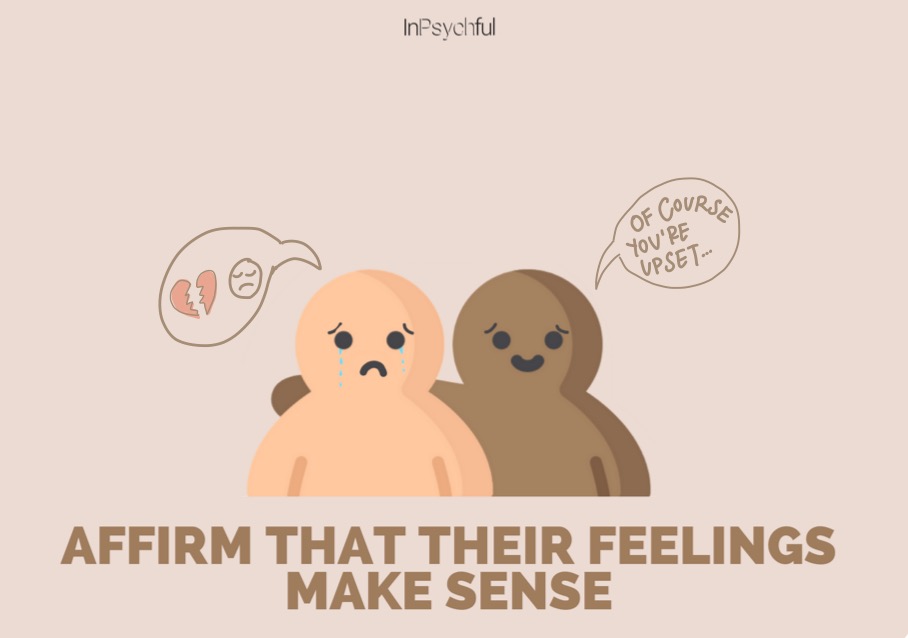Ever witnessed someone crying or grieving but find yourself tongue tied for words? It’s easy to celebrate someone’s joy, but what about when someone is hurting? Sometimes we find ourselves caught in the situation where a friend breaks into tears and we don’t know what to say, or what to do.
Firstly, before we dive in, it is important to understand the goal of comforting someone:
The primary goal of comforting is ease someone’s burden and suffering by helping to lighten their load. There are also other related goals such as letting the other person know that we care about them, or to let them know that you love them. Often, we also try to help the other person make sense of the situation or issue at hand, and to better understand their emotions (Lambert, 2019).
Now that we understand the goals of comforting someone, how do we be emotionally present and comfort someone who’s hurting? This article seeks to provide some tips on how we can be better listeners and learn how to comfort someone. Words are powerful tools and if used correctly, they can effectively ease someone’s pain.
How do we comfort someone?
More often than not, the most common scenario that people get stuck not knowing what to do or say is when a close friend starts crying. While there are tips on how we can provide emotional support and comfort to a friend or our partner, it is also important to note that comfort looks different for everyone. What might work for your friend, might not work for your partner. According to McKay and McKay (2019) these are the few steps we can take to comfort someone.
1. “Witness their feelings”
“I know that this is a hard time for you, and I know that you’re hurting…”
“I hear you.. It seems like you’re upset because…”
To start comforting someone, simply describe what you see or feel. By recognizing what you witness and affirm them by rephrasing what they just told you, in order to show and reaffirm them that you hear them. It also helps you to clarify that you are on the same page as them and prevent chances of misinterpreting their situation.
2. Affirm that their feelings make sense
“Of course you’re upset, I was honestly upset when … happened to me too.”
To affirm someone else’s feelings, try to use the same emotion word they used at well (e.g disappointed, heartbroken, etc). Sometimes, past personal experiences allows us to show that we are able to relate. However, be careful not to change the focus of the conversation to you, but rather, share to show that you empathise. Avoid comparing your past experience with theirs, but focus on the other person’s story.
3. Draw out their feelings inorder to better understand what they feel
“Tell me what happened… How did that make you feel?”
While some people do want advice or a solution to their problem, more often than not, people just want to be heard. By asking how something made them feel, we want to elicit more response from them. It is not solely just about what they felt but it’s how they felt that we can gain deeper insights to their world. By asking someone “how” instead of “what”, this avoids being caught in one-word replies. Even if you find yourself with a one-word reply to “how did that make you feel”, you would have given the person more room to share if they wanted to.
Instead of jumping straight to a proposed solution, it is important to see that your job is not to talk, but to get the other person to talk. By verbalising what and why they are feeling down, can we also better understand their feelings. Avoid asking ‘why’ questions, as they might come across as being critical, rather than encourage the other person to better understand their suffering.
4. Don’t minimize their pain or focus only on cheering them up
Your friend is not in the future, your friend is right now in the pain. Show up for them in the present
– Unknown
When the other person bursts into tears, it is natural for us to react with, “don’t cry…”, “you’ll feel better”, or “cheer up”. However, this is counter-intuitive, and might instead come across as trying to trivialize what the other person is feeling. Instead, of brushing their feelings aside or focusing on how they will feel better in the future, show up for them in the present (Tartakovsky, 2018)
5. Offer physical affection if appropriate
Sometimes, people don’t want to talk and don’t want you to talk either. Perhaps they might not be ready to share, but if it is appropriate, give him/her a hug. These physical affections should generally match the level of affection you show on a regular basis. If you’ve never hugged this person, then perhaps a hand on their shoulder would suffice, but if the person in your partner, a hug or a snuggle would be appropriate.
6. Affirm your support and commitment
Letting your friend know that you do care about them and that you’re sorry for what they’re going through is indeed important at that moment. While they might feel better after talking to you, reaffirm your support and let them know that you are
If you find yourself in the other position where your partner fails to comfort you at the times you need the most, there are some way to elicit emotional comfort from your partner. In other words, we can help them help us.
References
Lambert, B. (2019, June 7). How to Comfort Someone Who Is Hurting. Retrieved from https://www.theemotionmachine.com/how-to-comfort-someone-who-is-hurting/
McKay, K., & McKay, B. (2019, December 7). How to Comfort Someone Who’s Sad/Crying. Retrieved from https://www.artofmanliness.com/articles/how-to-comfort-someone-whos-sadcrying/
Shapiro, C. (2011, October 31). He Just Doesn’t Get How to Comfort Me! Retrieved from https://www.psychologytoday.com/sg/blog/when-youre-not-expecting/201110/he-just-doesnt-get-how-comfort-me
Tartakovsky, M. (2018, July 8). How to Sit with Someone Else’s Pain. Retrieved from https://psychcentral.com/blog/how-to-sit-with-someone-elses-pain/







